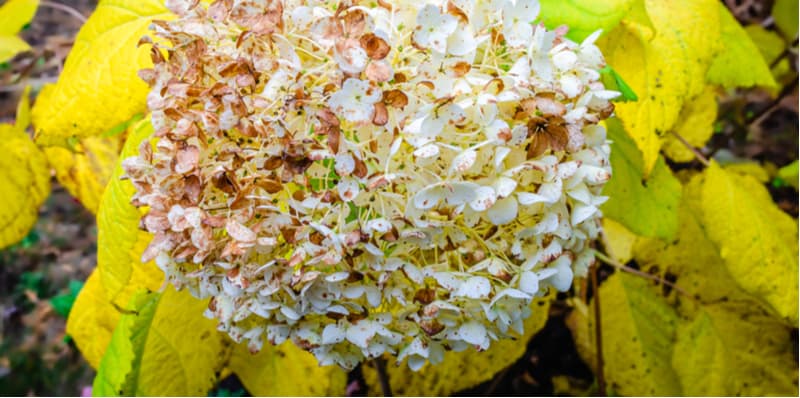The Greatest Guide To Hydrangea Leaves Turning Yellow
Table of ContentsThe Main Principles Of Hydrangea Leaves Turning Yellow Rumored Buzz on Hydrangea Leaves Turning YellowRumored Buzz on Hydrangea Leaves Turning YellowHow Hydrangea Leaves Turning Yellow can Save You Time, Stress, and Money.The 9-Minute Rule for Hydrangea Leaves Turning YellowOur Hydrangea Leaves Turning Yellow Ideas
One possibility is that the plant is not obtaining sufficient sunlight. During the winter season, the days are much shorter, and the sun is not as intense, so make certain to put your Hydrangea in an area where it will certainly access least 6 hours of sunlight each day. Another factor for Hydrangea yellow fallen leaves in winter season could be excessive water.The fallen leaves could be turning yellow due to temperature stress. Hydrangeas like cooler temperatures, so if the plant is in a spot that obtains also hot or as well cold, the fallen leaves will transform yellow. If you assume temperature level stress and anxiety may be the problem, attempt relocating your Hydrangea to a different place or securing it from the components with a burlap wrap.

The Facts About Hydrangea Leaves Turning Yellow Revealed
In the springtime when the mercury stays fairly low, they'll do great. When points warm up over the summertime however, time invested in the early afternoon rays can cause untold damage.: Grow your hydrangeas in an area where they'll get sunlight in the mornings or nights, however not during the peak hours.
Wilting is triggered by lack of moisture, implying there are a few good methods to utilize to avoid this from taking place - Hydrangea Leaves Turning Yellow. Give your hydrangeas a healthy and balanced glug of water every couple of days when the temperatures are climbing high, and treat the soil to much better preserve moisture. After sprinkling, a bit of compost around the base of each plant need to help with this by maintaining wetness in the soil

The Of Hydrangea Leaves Turning Yellow
As a general regulation of thumb, we recommend removing fallen leaves when they are 50% brownish or greater. While browning explanation caused by any type of reason can not be reversed, taking the rehabilitative action explained above will certainly motivate the plant to grow new leaves so the harmed fallen leaves either drop off normally or can be eliminated by the gardener.
Hydrangeas should be watered only when the leading few inches of dirt are dry, and need to be provided a detailed saturating each time. Underwatered hydrangeas are likely to have yellow, wilting, and drooping fallen leaves.
The means you take care of hydrangea leaves transforming yellow depends on the crucial issue triggering the yellow fallen leaves. This can be tough to identify, yet once you do you will certainly be able to change your plant treatment appropriately to look after the issue. Hydrangea Leaves Turning Yellow. As discussed previously, an usual concern with hydrangeas is vitamins and mineral shortages
Facts About Hydrangea Leaves Turning Yellow Uncovered
Throughout the height growing period, you should sprinkle at a rate of concerning 1 inch each week. If you are bothered with not correctly sprinkling your hydrangeas, there are a number of things you can do. Including mulch to the base of the plants over the root zone help to manage the temperature around the bush and maintain water in the soil.
You can purchase and set up simple watering worlds. Sprinkling globes hold water in them and gradually release this water into the dirt as the ground becomes dry. Just fill the globe with water, stick the spout right into the soil within the root area near the base of the plant, and leave it published here in position up until all the water is gone.
If it is also severe, some plants will certainly never recover More hints from transplant shock and will continue to decline until they die. Lessen transplant shock by consisting of as several roots as possible when excavating up your plant to move it. Be sure to provide even more water than usual in the weeks following planting to aid your plant recover and grow brand-new roots.
What Does Hydrangea Leaves Turning Yellow Mean?

To stay clear of spreading fungal illness, be sure to thouroughly clean and sanitize any type of pruning tools prior to and after usage. You can try to purge the roots with water to get rid of excess fertlizer.
Your hydrangea plant prefers well-drained, moist soil. If the pot has bad drain, or your soil is swamped, the fallen leaves will certainly begin to turn yellow.
If you don't water your hydrangea plant for even more than a week, the fallen leaves will certainly begin transforming yellow. Fungal illness that strike the plants often tend to reveal indications on the roots and the leaves of the plant.
Hydrangea Leaves Turning Yellow Can Be Fun For Anyone
Origin rot occurs when microorganisms use up the root cells as hosts and quit the cell from working. Otherwise cared for, this condition can at some point cause the plant dying. Fallen leave spot is an additional fungal condition that can target hydrangea. It leads to the leaves transforming yellow and the look of brown and purple places on the fallen leaves.